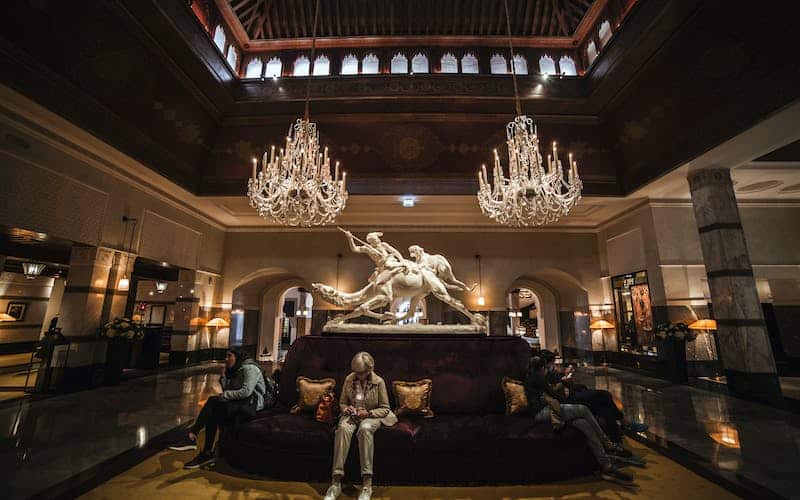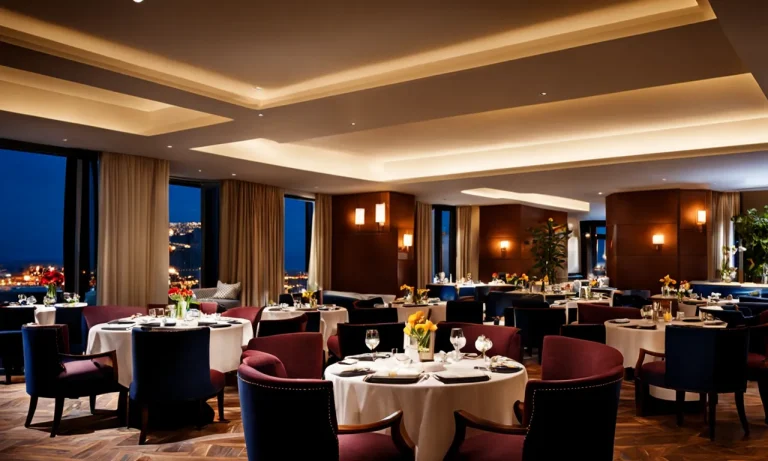An optimal organizational structure is crucial for hotels to deliver quality guest experiences and drive profitability. However, with many viable options, determining the best structure can be a challenge.
If you’re short on time, here’s a quick answer: Most hotels use a functional structure with departments for key operations like front office, housekeeping, food and beverage, sales/marketing, HR, accounting, and maintenance.
This comprehensive guide examines the pros and cons of different hotel organizational structures, provides examples, and offers tips for choosing an approach tailored to your property’s needs.
Overview of Hotel Organizational Structures
When it comes to running a successful hotel, having the right organizational structure is crucial. A well-designed structure ensures that tasks are efficiently assigned, roles are clearly defined, and communication flows smoothly throughout the organization.
There are several different types of organizational structures that hotels can adopt, each with its own advantages and disadvantages. In this article, we will provide an overview of the most common hotel organizational structures to help you determine which one might be the best fit for your hotel.
Functional Structure
The functional structure is one of the most traditional and widely used organizational structures in the hotel industry. In this type of structure, the hotel is divided into different departments based on functions such as operations, sales and marketing, human resources, finance, and housekeeping.
Each department is headed by a department manager who reports to the general manager or hotel owner. The functional structure allows for specialization and expertise within each department, but it can also lead to silos and a lack of collaboration between departments.

Divisional Structure
The divisional structure is often adopted by larger hotel chains or hotels with multiple properties. In this structure, the hotel is divided into divisions based on geographic location or market segment.
For example, a hotel chain may have separate divisions for its properties in different countries, or a hotel may have divisions for leisure travelers and business travelers. Each division operates as a separate entity with its own resources and decision-making power.
The divisional structure allows for greater flexibility and responsiveness to local market conditions, but it can also result in duplication of resources and a lack of centralized control.
Matrix Structure
The matrix structure is a hybrid organizational structure that combines elements of both the functional and divisional structures. In this structure, employees are grouped by both function and product or project.
For example, a hotel may have a marketing department headed by a marketing manager, but also have cross-functional teams responsible for specific projects such as a rebranding campaign or a new hotel opening.
The matrix structure allows for both specialization and collaboration, but it can also lead to confusion and conflicts in reporting lines.
Flat Structure
The flat structure is a more decentralized and less hierarchical organizational structure commonly found in boutique hotels or smaller independent properties.
In this structure, decision-making authority is distributed among a smaller team of managers or even shared among all employees. The flat structure promotes a more collaborative and agile work environment, but it can also result in a lack of clear roles and responsibilities.
Hybrid Structure
The hybrid structure is a combination of two or more organizational structures. For example, a hotel may have a functional structure for its operational departments, a divisional structure for its different properties, and a matrix structure for its project teams.
The hybrid structure allows for customization and flexibility to meet the specific needs of the hotel, but it can also be complex to manage.
Ultimately, there is no one-size-fits-all answer to what the best organizational structure is for a hotel.
The right structure will depend on factors such as the size and complexity of the hotel, its goals and objectives, and the culture and leadership style of the organization.
It is important for hotel owners and managers to carefully consider these factors and seek professional advice if needed to determine the most suitable organizational structure for their hotel.
Functional Hotel Organization Structure
Centralized departments by function
In a functional hotel organization structure, departments are grouped based on their specific functions.
This means that all departments related to a particular function, such as finance, human resources, or marketing, are centralized and report to a single authority within the hotel. This structure allows for clear lines of authority and accountability within each department.

Clear roles and responsibilities
One of the key advantages of a functional hotel organization structure is that it provides clear roles and responsibilities for each department.
Each department has a specific function and is responsible for carrying out tasks related to that function. This clarity helps to avoid confusion and ensures that tasks are completed efficiently and effectively.
Promotes specialization
A functional hotel organization structure promotes specialization within each department. By having dedicated departments for specific functions, employees can focus on developing expertise in their respective areas. This leads to improved efficiency and quality in delivering services to guests.
Can cause communication silos
While a functional hotel organization structure has its benefits, it can also lead to communication silos. Since each department operates independently, there is a risk of limited communication and collaboration between departments. This can result in a lack of coordination and potential issues in delivering a seamless guest experience.
Common structure for most hotels
The functional hotel organization structure is the most common structure used by hotels. It provides a logical and efficient way to divide and manage different functions within the hotel. This structure has been proven to work well in the hospitality industry and is widely adopted by hotels of all sizes.
Divisional Hotel Organization Structure
One common organizational structure used in hotels is the divisional structure. This structure divides the hotel into various departments based on hotel areas or functions.
Each department operates as a separate division with its own goals, responsibilities, and resources. The divisional structure offers several advantages and disadvantages for hotels to consider.
Departments Divided by Hotel Area
In a divisional hotel organization structure, departments are typically divided based on hotel areas. For example, there might be divisions for front office, housekeeping, food and beverage, sales and marketing, and maintenance.
This division allows each department to focus on its specific area of expertise and ensures that the hotel runs smoothly and efficiently.
Additionally, having separate divisions allows for specialization and expertise within each department. This can lead to improved performance and guest satisfaction. For example, the front office division can focus solely on guest check-in/check-out processes and guest services, while the housekeeping division can concentrate on maintaining cleanliness and comfort in guest rooms.

Empowered Decision-Making
Another advantage of the divisional structure is that it empowers decision-making at the departmental level. Each division is headed by a department manager who has the authority to make decisions and manage their department’s resources.
This decentralized decision-making process can lead to quicker responses to guest needs and more efficient operations. By giving department managers the autonomy to make decisions, they can tailor their department’s operations to meet the needs and expectations of guests. This flexibility can result in a more personalized and enjoyable guest experience.
Aligns with Guest Experiences
The divisional structure aligns with the guest experiences in a hotel. Each division focuses on a specific aspect of the guest experience and works together to provide a seamless and memorable stay.
For example, the front office division handles guest check-in/check-out and ensures a smooth arrival and departure experience, while the food and beverage division takes care of dining options and room service.
This alignment ensures that each department is dedicated to meeting the needs and expectations of guests, resulting in a positive overall experience. It also allows for effective coordination and communication between departments to deliver exceptional service throughout a guest’s stay.
Can Create Redundancies
While the divisional structure offers many advantages, it can also create redundancies in certain areas. Each division may have its own set of resources and staff, which can lead to duplication of efforts and increased costs.
For example, there might be separate sales and marketing teams in each division, resulting in duplicated marketing strategies and expenses.
To mitigate redundancies, it is essential for hotel management to implement effective communication and coordination mechanisms between divisions. This ensures that departments work together efficiently and share resources when necessary, minimizing unnecessary costs.
Used in Large Convention Hotels
The divisional structure is commonly used in large convention hotels, where there is a need for specialized departments and a high level of coordination. These hotels often have numerous divisions, such as event planning, banquet services, audiovisual, and guest services, to handle the complex needs of large-scale events.
The divisional structure allows for efficient management of the various departments involved in organizing and executing conventions and events. It ensures that each division can focus on its specific responsibilities while working together seamlessly to provide exceptional experiences for event attendees.
Matrix Hotel Organization Structure
The matrix hotel organization structure is a unique approach that combines both functional and project-based reporting relationships. This type of organizational structure is commonly seen in larger hotels, especially those in the luxury segment.
It offers a range of benefits and challenges that hoteliers need to consider when determining the best organizational structure for their property.
Dual reporting relationships
One of the key features of the matrix structure is the presence of dual reporting relationships. This means that employees have two supervisors – one from their functional department and another from their project team.
For example, a front desk agent might report to the front office manager for their day-to-day tasks, but also to the project manager for a specific initiative or project. This allows for a more balanced distribution of authority and expertise.
Balance functional expertise and guest focus
The matrix structure is designed to balance functional expertise with a strong focus on guest satisfaction. By having employees work on both functional tasks and project-based initiatives, hotels can ensure that their staff members have a well-rounded skill set and are able to provide exceptional service to guests.
This approach also encourages cross-functional collaboration, as employees from different departments come together to work on specific projects.

Enhances flexibility and collaboration
The matrix structure enhances flexibility and collaboration within the hotel. Employees have the opportunity to work on a variety of projects, allowing them to develop new skills and gain exposure to different areas of the business.
This can lead to increased innovation and creativity, as employees bring their unique perspectives and expertise to the table. Additionally, the matrix structure promotes teamwork and fosters a sense of camaraderie among employees, as they work together to achieve common goals.
Can cause confusion with mixed direction
While the matrix structure has its advantages, it can also cause confusion and mixed direction among employees. With multiple supervisors and reporting lines, employees may find it difficult to prioritize their tasks and manage their time effectively.
This can lead to conflicting priorities and a lack of clarity in terms of expectations. To mitigate this challenge, communication and coordination between supervisors is crucial, ensuring that employees receive clear guidance and direction.
Seen primarily in luxury hotels
The matrix structure is primarily seen in luxury hotels, where the complexity of operations and the need for specialization are higher. These properties often have multiple departments and a wide range of projects and initiatives happening simultaneously.
The matrix structure allows for greater coordination and collaboration across departments, ensuring that the hotel operates smoothly and efficiently. However, it may not be suitable for smaller hotels with fewer departments and a simpler organizational structure.
Flat vs. Tall Hotel Structures
Flat: Few Management Layers
A flat hotel structure refers to an organizational setup with few management layers. In this type of structure, decision-making authority is decentralized, allowing for a more collaborative and agile working environment.
A flat structure promotes open communication and empowers employees at all levels to contribute their ideas and suggestions. This can lead to a greater sense of ownership and motivation among staff members, as they feel valued and involved in the decision-making process.
According to a study conducted by HospitalityNet, hotels with a flat structure typically experience higher employee satisfaction and lower turnover rates. The streamlined communication channels and reduced bureaucracy in a flat structure enable faster decision-making, which can be crucial in an industry where timely responses are essential to meet customer needs and demands.
Tall: More Hierarchical Levels
A tall hotel structure, on the other hand, involves multiple hierarchical levels and a more traditional chain of command.
In a tall structure, decision-making authority is concentrated at the top, with fewer individuals having the power to make significant decisions. This type of structure provides a clear and defined reporting structure, ensuring accountability and oversight.
Tall structures often work well in larger hotels where a higher level of oversight is necessary to manage the complex operations and diverse departments. The presence of more hierarchical levels allows for better coordination and control over different functions, ensuring smooth operations and adherence to established standards.
Flat Fosters Faster Decisions
In a flat hotel structure, decisions can be made more quickly as there are fewer layers of approval required. This enables the hotel to respond promptly to changing market conditions, customer preferences, and emerging trends.
The collaborative nature of a flat structure encourages innovation and creativity, as employees feel empowered to propose and implement new ideas without excessive bureaucratic hurdles.
Furthermore, a flat structure promotes a sense of trust and autonomy among employees, leading to a more positive and productive work environment. When employees are given the authority to make decisions and contribute to the success of the hotel, they are more likely to feel motivated and engaged, resulting in improved performance and customer satisfaction.
Tall Provides More Oversight
On the other hand, a tall hotel structure provides a higher level of oversight and control over operations. With more hierarchical layers, there are clear lines of authority and responsibility, ensuring that decisions are made in accordance with the hotel’s overall strategy and objectives.
This hierarchical structure can be particularly beneficial in maintaining consistency and standardization across different departments and locations.
A tall structure also allows for effective coordination and supervision of employees, ensuring that tasks are carried out efficiently and according to established protocols. The presence of multiple management levels enables the hotel to closely monitor performance, identify areas for improvement, and implement necessary changes.
Larger Hotels Tend Toward Tall Structures
It is important to note that the choice between a flat or tall hotel structure often depends on the size and complexity of the hotel.
Larger hotels with multiple departments and a wide range of functions tend to adopt tall structures to ensure effective coordination and control. The need for oversight and standardized procedures becomes more crucial as the hotel’s scale and scope increase.
However, smaller boutique hotels or independent establishments may opt for a flat structure to encourage a more collaborative and agile work environment. In such cases, the emphasis is often on fostering innovation, employee empowerment, and quick decision-making to stay competitive in the dynamic hospitality industry.

Conclusion
The optimal hotel organizational structure depends on your property’s size, class, offerings, and objectives.
Most leverage a functional structure or matrix to balance expertise and guest centricity. Analyze your needs and culture to determine the best fit.
With clear direction setting, any structure can enable hotel success.






